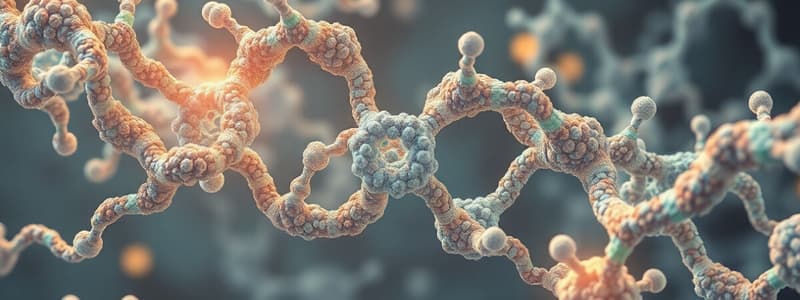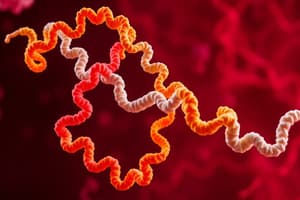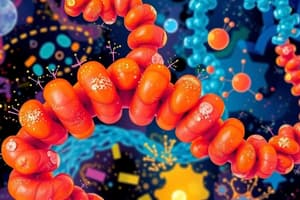Podcast
Questions and Answers
What can happen to an enzyme at suboptimal temperatures?
What can happen to an enzyme at suboptimal temperatures?
- The enzyme increases its substrate binding affinity.
- The enzyme becomes more efficient.
- The enzyme maintains its shape.
- The enzyme can denature and lose its shape. (correct)
What occurs when a substrate binds to the active site of an enzyme?
What occurs when a substrate binds to the active site of an enzyme?
- The substrate forms permanent bonds with the enzyme.
- The enzyme is destroyed by the substrate.
- The substrate becomes inactivated.
- Temporary bonds are formed, weakening original substrate bonds. (correct)
What is the function of the enzyme-substrate complex?
What is the function of the enzyme-substrate complex?
- It breaks down the substrate into amino acids.
- It allows new bonds to form between substrates. (correct)
- It creates permanent bonds between enzyme and substrate.
- It increases the activation energy required for the reaction.
What is activation energy?
What is activation energy?
What role do catalysts play in biochemical reactions?
What role do catalysts play in biochemical reactions?
What happens to the enzyme-substrate complex after the reaction?
What happens to the enzyme-substrate complex after the reaction?
Which factor does NOT affect enzyme function?
Which factor does NOT affect enzyme function?
What must happen to the energy from exergonic reactions for it to be used in endergonic reactions?
What must happen to the energy from exergonic reactions for it to be used in endergonic reactions?
Which of the following best describes ATP's role in cells?
Which of the following best describes ATP's role in cells?
What is the outcome when ATP is broken down?
What is the outcome when ATP is broken down?
Which statement correctly describes oxidation and reduction?
Which statement correctly describes oxidation and reduction?
What does the acronym OIL RIG stand for?
What does the acronym OIL RIG stand for?
In oxidation-reduction reactions, what role does a reducing agent play?
In oxidation-reduction reactions, what role does a reducing agent play?
Why is oxygen considered a strong oxidizing agent?
Why is oxygen considered a strong oxidizing agent?
What is the unstable state called when reactants become contorted and able to break or make bonds?
What is the unstable state called when reactants become contorted and able to break or make bonds?
What happens during endergonic reactions?
What happens during endergonic reactions?
How do enzymes help substrates reach their transition state?
How do enzymes help substrates reach their transition state?
Which of the following factors does NOT alter enzyme activity?
Which of the following factors does NOT alter enzyme activity?
Which enzyme is specifically responsible for adding phosphate groups?
Which enzyme is specifically responsible for adding phosphate groups?
What effect does increasing temperature have on enzyme activity?
What effect does increasing temperature have on enzyme activity?
What suffix do all enzymes end with, indicating their functional role?
What suffix do all enzymes end with, indicating their functional role?
Which statement about the activation energy of a catalyzed reaction is true?
Which statement about the activation energy of a catalyzed reaction is true?
What best describes the role of cofactors and coenzymes in enzyme activity?
What best describes the role of cofactors and coenzymes in enzyme activity?
What drives a reversible chemical reaction according to the law of mass action?
What drives a reversible chemical reaction according to the law of mass action?
What results from the phenomenon of end product inhibition?
What results from the phenomenon of end product inhibition?
Which of the following best describes branched metabolic pathways?
Which of the following best describes branched metabolic pathways?
What is a primary function of enzymes in biological reactions?
What is a primary function of enzymes in biological reactions?
How does allosteric inhibition function within a metabolic pathway?
How does allosteric inhibition function within a metabolic pathway?
What occurs as a result of an inborn error of metabolism?
What occurs as a result of an inborn error of metabolism?
Which model describes the initial interaction between an enzyme and its substrate?
Which model describes the initial interaction between an enzyme and its substrate?
According to the first law of thermodynamics, what is true about energy?
According to the first law of thermodynamics, what is true about energy?
How do enzymes facilitate reactions without being consumed?
How do enzymes facilitate reactions without being consumed?
What determines the specific function of an enzyme?
What determines the specific function of an enzyme?
What is the role of carbonic anhydrase in the body?
What is the role of carbonic anhydrase in the body?
What are the reactants called that enzymes act upon?
What are the reactants called that enzymes act upon?
What is the purpose of negative feedback at branch points in metabolic pathways?
What is the purpose of negative feedback at branch points in metabolic pathways?
Which statement about enzymes is true?
Which statement about enzymes is true?
What occurs during the induced-fit model of enzyme activity?
What occurs during the induced-fit model of enzyme activity?
What can be concluded about enzyme specificity?
What can be concluded about enzyme specificity?
What occurs to an enzyme when the temperature exceeds a few degrees above normal body temperature?
What occurs to an enzyme when the temperature exceeds a few degrees above normal body temperature?
How does decreasing the temperature affect molecular motion in reactions?
How does decreasing the temperature affect molecular motion in reactions?
What does 'saturation' mean in relation to enzyme activity?
What does 'saturation' mean in relation to enzyme activity?
What is the primary role of coenzymes in enzyme activity?
What is the primary role of coenzymes in enzyme activity?
What is the significance of a zymogen in enzymatic activity?
What is the significance of a zymogen in enzymatic activity?
What happens to enzymes when extreme pH changes occur?
What happens to enzymes when extreme pH changes occur?
Why are co-factors important for enzyme activity?
Why are co-factors important for enzyme activity?
What is true about the pH optimum of enzymes?
What is true about the pH optimum of enzymes?
Flashcards
Transition State
Transition State
The unstable state a molecule reaches when its bonds are being broken or made, allowing a reaction to occur quickly. This unstable state is caused by the enzyme.
Catalyst
Catalyst
A substance that speeds up a chemical reaction by lowering its activation energy but is not consumed in the reaction itself.
Activation Energy
Activation Energy
The minimum amount of energy required for a reaction to occur.
Enzyme
Enzyme
Signup and view all the flashcards
Active Site
Active Site
Signup and view all the flashcards
Substrate
Substrate
Signup and view all the flashcards
Enzyme Activity
Enzyme Activity
Signup and view all the flashcards
Factors Affecting Enzyme Activity
Factors Affecting Enzyme Activity
Signup and view all the flashcards
Enzyme-Substrate Complex
Enzyme-Substrate Complex
Signup and view all the flashcards
Enzyme Catalysis
Enzyme Catalysis
Signup and view all the flashcards
Denaturation
Denaturation
Signup and view all the flashcards
Enzyme's Impact on Activation Energy
Enzyme's Impact on Activation Energy
Signup and view all the flashcards
What are enzymes?
What are enzymes?
Signup and view all the flashcards
Can enzymes be reused?
Can enzymes be reused?
Signup and view all the flashcards
Do enzymes change what happens in a reaction?
Do enzymes change what happens in a reaction?
Signup and view all the flashcards
How do enzymes make reactions faster?
How do enzymes make reactions faster?
Signup and view all the flashcards
What determines the shape of a protein?
What determines the shape of a protein?
Signup and view all the flashcards
What is the active site of an enzyme?
What is the active site of an enzyme?
Signup and view all the flashcards
What is the Lock-and-Key model?
What is the Lock-and-Key model?
Signup and view all the flashcards
What is the Induced-Fit model?
What is the Induced-Fit model?
Signup and view all the flashcards
Enzyme Optimum Temperature
Enzyme Optimum Temperature
Signup and view all the flashcards
Enzyme Denaturation
Enzyme Denaturation
Signup and view all the flashcards
Zymogen
Zymogen
Signup and view all the flashcards
Coenzymes
Coenzymes
Signup and view all the flashcards
Cofactors
Cofactors
Signup and view all the flashcards
Enzyme Saturation
Enzyme Saturation
Signup and view all the flashcards
Law of Mass Action
Law of Mass Action
Signup and view all the flashcards
Metabolic Pathway
Metabolic Pathway
Signup and view all the flashcards
Branched Metabolic Pathways
Branched Metabolic Pathways
Signup and view all the flashcards
End Product Inhibition
End Product Inhibition
Signup and view all the flashcards
Allosteric Inhibition
Allosteric Inhibition
Signup and view all the flashcards
Inborn Errors of Metabolism
Inborn Errors of Metabolism
Signup and view all the flashcards
First Law of Thermodynamics
First Law of Thermodynamics
Signup and view all the flashcards
Bioenergetics
Bioenergetics
Signup and view all the flashcards
Coupled Reactions: Energy Transfer
Coupled Reactions: Energy Transfer
Signup and view all the flashcards
What is ATP?
What is ATP?
Signup and view all the flashcards
How is ATP made?
How is ATP made?
Signup and view all the flashcards
How is energy released from ATP?
How is energy released from ATP?
Signup and view all the flashcards
What is Reduction?
What is Reduction?
Signup and view all the flashcards
What is Oxidation?
What is Oxidation?
Signup and view all the flashcards
Coupled Reactions: Oxidation and Reduction
Coupled Reactions: Oxidation and Reduction
Signup and view all the flashcards
Why is oxygen important in oxidation?
Why is oxygen important in oxidation?
Signup and view all the flashcards
Study Notes
Enzymes
- Enzymes are biological catalysts
- Increase the rate of a reaction
- Not changed by the reaction (reusable)
- Do not change the nature of the reaction
- Lower the activation energy of the reaction
Protein Structure Revisited
- First level: Amino acids bond to form a chain.
- Second level: Attraction between amino acids causes pleated ribbon or coiled rod shapes.
- Third level: Pleated ribbons and coiled rods fold into a 3D structure.
- Fourth level: Multiple folded proteins connect to form a single protein molecule
Mechanisms of Enzyme Activity
- Enzyme function is dictated by structure
- Enzymes have a characteristic 3D shape with active sites
- Reactants are called substrates
- Original model: substrates fit into the active site (lock-and-key model)
- Updated model: Substrate fit isn't exact, it changes shape slightly as it enters the active site (induced-fit model)
- Enzymes are very specific to their substrates
3D Image of Enzyme Active Site
- Protein structure supports and positions active sites.
- Binding sites bind and orient substrates.
- Catalytic sites reduce activation energy
Metabolic Pathways
- Linked chemical Reactions in chains or webs.
- Begin with an initial substrate and end with a product.
- Involve many enzymatic steps along the way
Branched Metabolic Pathways
- Not always linear
- Often include branches where multiple products form
Metabolic Pathway Inhibition
- End product inhibition occurs when the end product of a metabolic pathway blocks an earlier step in that pathway.
- This is a form of negative feedback.
- The end products bind to enzymes at a spot away from the active site, which alters the enzyme's shape, preventing binding to the substrate.
Inborn Errors of Metabolism
- Gene mutations in DNA lead to flawed enzymes.
- This impacts the pathways that follow the defective enzyme.
- Leads to product build-up or lack of products as reactions cannot effectively proceed.
- Can lead to fatal conditions in the fetus.
Effects of pH
- Enzymes work best within a narrow pH range (optimum pH).
- Extreme pH changes denature enzymes, altering their shape and function.
- Optimum pH typically matches the pH where the enzyme functions (e.g. stomach vs saliva)
Effect of Substrate Concentration
- Increasing substrate concentration initially increases the rate of the reaction.
- The rate of the reaction plateaus when all enzyme active sites are continuously occupied thus reaching saturation.
Coenzymes and Cofactors
- Coenzymes are organic molecules and cofactors are inorganic metal ions that assist enzymes in various reactions often by affecting active site shape, or assisting in temporary bonding between the enzyme and substrates.
- Coenzymes often transport small molecules or atoms (like hydrogen)
- Cofactors help shape the active sites of enzymes, aid in enzyme substrate bonding
Zymogens
- Some enzymes are produced in an inactive form called zymogens.
- The suffix -ogen helps identify these enzymes (e.g. pepsinogen).
- Zymogens require activation via other enzymes (e.g. phosphorylation) to become active
Law of Mass Action
- Some chemical reactions are reversible.
- The rate of reaction depends on substrate and product concentrations.
- Reactions tend towards the side of the reaction with the lower concentration of products/reactants.
Laws of Thermodynamics
- First Law: Energy cannot be created or destroyed, only transferred.
- Second Law: Energy is lost as heat, resulting in a decrease in usable energy during transformations.
- Energy transfers are inefficient
Endergonic and Exergonic Reactions
- Endergonic reactions require energy input to proceed.
- Reactants have less free energy than products.
- Exergonic reactions release energy to proceed.
- Reactants have more free energy than products.
Coupled Reactions: ATP
- Cells use energy stored in chemical bonds via ATP, an energy carrier
- ATP is synthesized from ADP and phosphate using energy from exergonic reactions.
- ATP releases energy when broken down into ADP.
Coupled Reactions: Oxidation and Reduction
- Reactions are linked; electrons are transferred or hydrogen atoms.
- Reduction is gaining electrons/hydrogen.
- Oxidation is losing electrons/hydrogen.
- Some molecules are oxidizing/reducing agents, depending on the reaction
Hydrogen Carriers
- Coenzymes that accept/donate hydrogen atoms in redox reactions (e.g., NAD, FAD).
- These coenzymes (NAD and FAD) play a role in energy production by carrying electrons in coupled reactions.
Studying That Suits You
Use AI to generate personalized quizzes and flashcards to suit your learning preferences.



